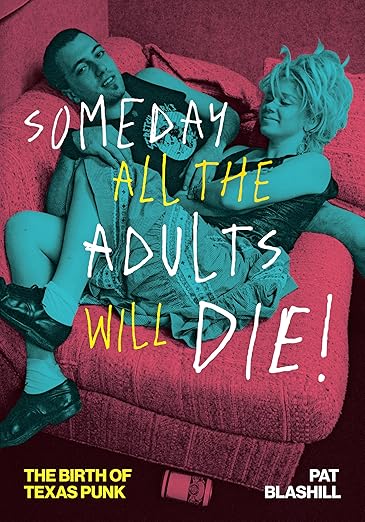By Cameron Tepper
Following up the 2020 photo collection work, Texas Is the Reason: The Mavericks of Lone Star Punk, music and photojournalist Pat Blashill chronicles the origins of the Texas punk scene, specifically Austin, in his newest work, Someday All the Adults will Die!: The Birth of Texas Punk. Using an oral history format similar to UTexas press’s other recent work, A Curious Mix of People, Blashill lets the many participants illustrate their own scene in their words—including members of the Big Boys, The Dicks, Butthole Surfers—who started the movement in the late ’70s through the ’80s.
Largely born out of Raul’s, a Tejano-turned-punk bar near The University of Texas at Austin, management started taking a chance on punk and new wave acts, booking them every night of the week. Since the origin, punks in Austin, Dallas, Houston, and San Antonio spoke out against racism, religious hypocrisy, sexism, homophobia, and everything else you might expect in Reagan-era Texas. As Blashill says, “Punk didn’t flourish in the Lone Star State in spite of local conditions, but because of them.”
A heavy focus of the work is spent on identifying what made this scene unique specific to the Texan region, with a heavy embracing of queer and Texan aesthetics where nothing was forbidden and everything was permitted, initiated first by Randy “Biscuit” Turner of Big Boys and Gary Floyd of The Dicks, later amplified by Butthole Surfers. “We were doing Texas drag, just playing up the hillbilly role” says Jeffrey “King” Coffey of Butthole Surfers. Daniel Johnston is also included with the spirit of D.I.Y. punk in his self recorded tapes distributed by hand with hand drawn J-sleeve cassettes. As with most punk scenes of this time, it skewed heavily white and male. Blashill makes a concerted effort to explore the gender and race components of the scene, highlighting the femmes in the punk scene.
As a resident of Austin, the age-old adage to any new resident of the capitol city is, “You missed it. You should have gotten here five years ago.” Austinites have a habit of navel gazing, remembering “the good ol’ days” of what once was, but Blashill walks the line well to document the scene, warts and all, while still highlighting the DIY spirit, wild performance, and page-turning anecdotes from stalwarts of the scene who challenged every audience member to go out and start their own band.

